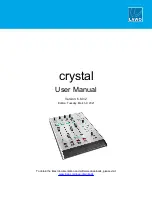
10. Application Guide
80
PLM+ SERIES Operation Manual rev 3.0.1
10.3.2. Minimize Noise
To help provide the best volume to noise ratio, use an AES or Dante digital input signal wherever possible. If using
analog inputs, ensure that unused or unnecessarily high headroom is not introduced at the input to the device. If
full or high average power is not required, the Module input gain may be reduced.
10.3.3. Gain Optimization Examples
This section provides examples on performance effects resulting from changes to the PLM+ gain structure
10.3.3.1. Digital Input Gain Structure Examples
•
Input Clip: 0 dBFS
•
Amp Gain: 35 dB
•
SNR: 114.2 dB
•
Absolute Noise Floor: -71.3 dBu
Table 10.2: Digital Input: Low Noise with Good Headroom (High Input / High SPL)
Figure 10.3 illustrates how to achieve the lowest possible output noise, although this is not a recommended
•
Input Clip: 0 dBFS
•
Amp Gain: 22 dB
•
SNR: 114.8 dB
•
Absolute Noise Floor: -71.9 dBu
Table 10.3: Digital Input Optimized for Minimum Noise - Not Recommended
-250,0
-200,0
-150,0
-100,0
-50,0
0,0
50,0
100,0
Analog
AES Input
Input Mixer
Module In
Module Out
Amp
Attenuation
Analog Ref
Amp Gain
ISVPL
Output
dB
/d
B
u
Clip
Nominal
Noise
-250,0
-200,0
-150,0
-100,0
-50,0
0,0
50,0
100,0
Analog
AES Input
Input Mixer
Module In
Module Out
Amp
Attenuation
Analog Ref
Amp Gain
ISVPL
Output
dB
/d
B
u
Clip
Nominal
Noise













































